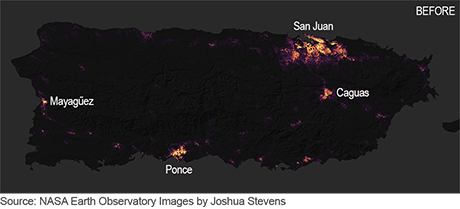Did Import Competition Boost Household Debt Demand?

In the years preceding the Great Recession, the United States experienced a dramatic rise in household debt and an unprecedented increase in import competition. In a recent staff report, we outline a link between these two seemingly unrelated phenomena. We argue that the displacement of workers exposed to import competition fueled their demand for mortgage credit, which left many households more vulnerable to the eventual downturn in the housing market.
What about Spending on Consumer Goods?

In a recent Liberty Street Economics post, I showed that one major category of consumer spending—spending on discretionary services such as recreation, transportation, and household utilities—behaved very differently in the 2007-09 recession and subsequent recovery than in previous business cycles: specifically, it fell more steeply and has recovered much more slowly.
Beginning to Gauge Maria’s Effect on Puerto Rico’s Economy

Just two weeks after most of Puerto Rico dodged the proverbial bullet, missing the brunt of Hurricane Irma, the island was devastated by Maria—one of the ten strongest Atlantic hurricanes on record. Making landfall on September 20, 2017, the storm caused not only massive physical destruction and tragic loss of life but also widespread and persistent power outages, shortages of potable (and even nonpotable) running water, and disruptions to telecommunications and travel, among other issues. With the storm boosting costs and disrupting activity, the short-term economic impact is clearly significant. But an even greater concern is that the adverse short-term effects of the storm, overlaid on an already shrinking economy, may evolve into long-term adverse effects. In this post, we focus on the magnitude, duration, breadth and nature of the economic disruptions, as measured mostly by employment.
The ‘Banking Desert’ Mirage

Donald P. Morgan, Maxim L. Pinkovskiy, and Davy Perlman Editor’s note: The original version of this post misstated the share of the population that is unbanked for several states. The table, interactive chart, and related text have been corrected. These changes did not alter our conclusion that across states, the share of the population that […]
Fiscal Implications of the Federal Reserve’s Balance Sheet Normalization

In the wake of the global financial crisis, the Federal Reserve dramatically increased the size of its balance sheet—from about $900 billion at the end of 2007 to about $4.5 trillion today. At its September 2017 meeting, the Federal Open Market Committee (FOMC) announced that—effective October 2017—it would initiate the balance sheet normalization program described in the June 2017 addendum to the FOMC’s Policy Normalization Principles and Plans.
Balance Sheet Normalization: When Will Agency MBS Holdings Decline?

Andreas Fuster, Brian Greene, and Brett Rose In its September 20, 2017, statement, the Federal Open Market Committee (FOMC) said that, beginning in October 2017, it would initiate the balance sheet normalization program described in the June 2017 addendum to the Committee’s Policy Normalization Principles and Plans. Specifically, to reduce the Federal Reserve’s securities holdings, […]










 RSS Feed
RSS Feed Follow Liberty Street Economics
Follow Liberty Street Economics